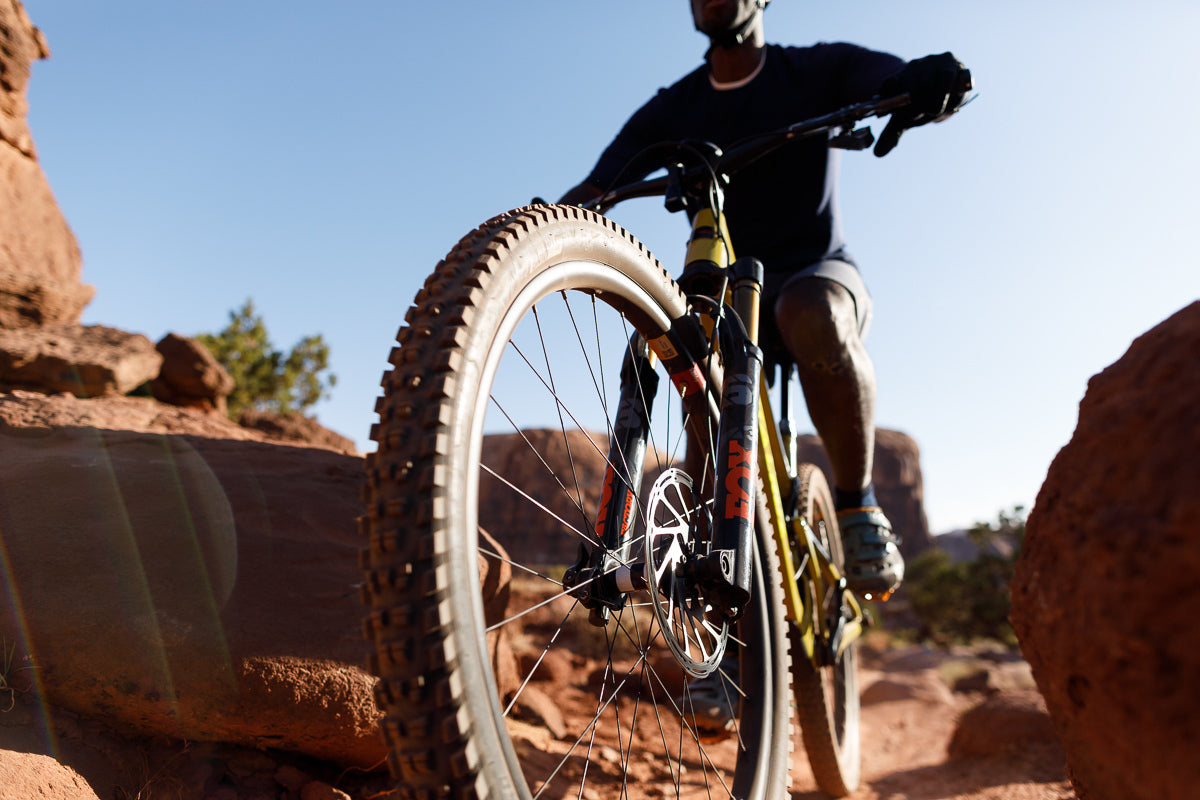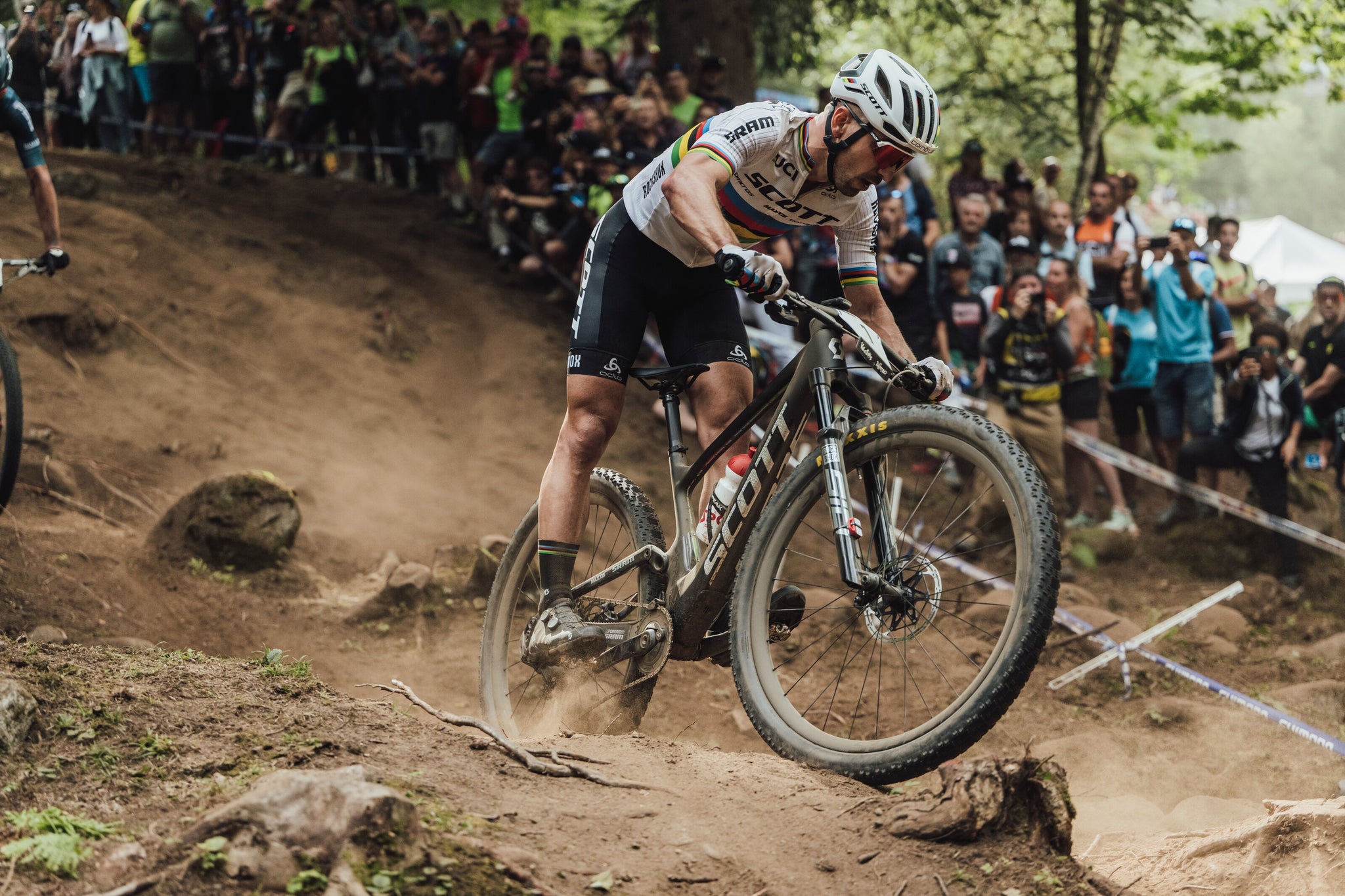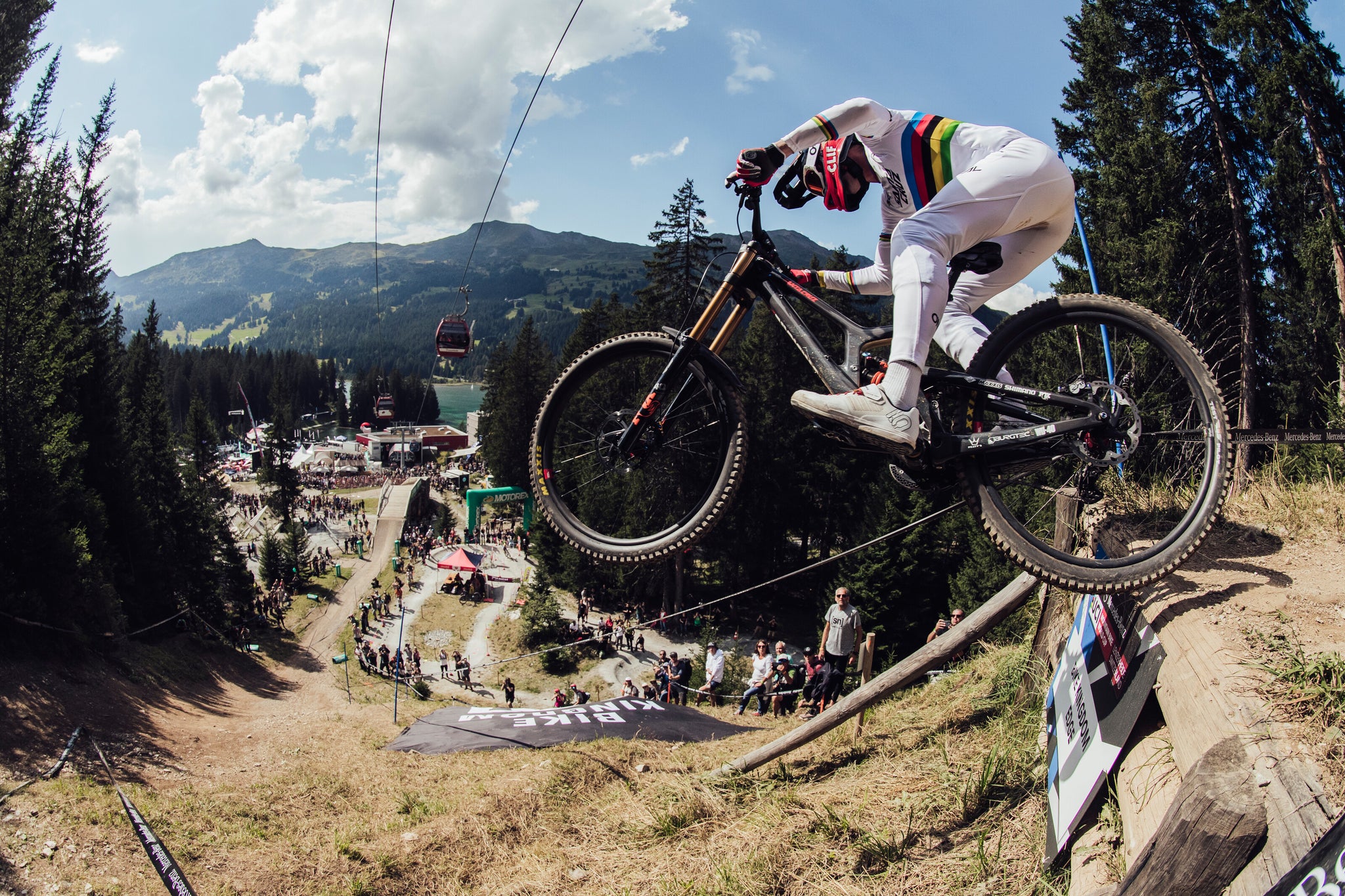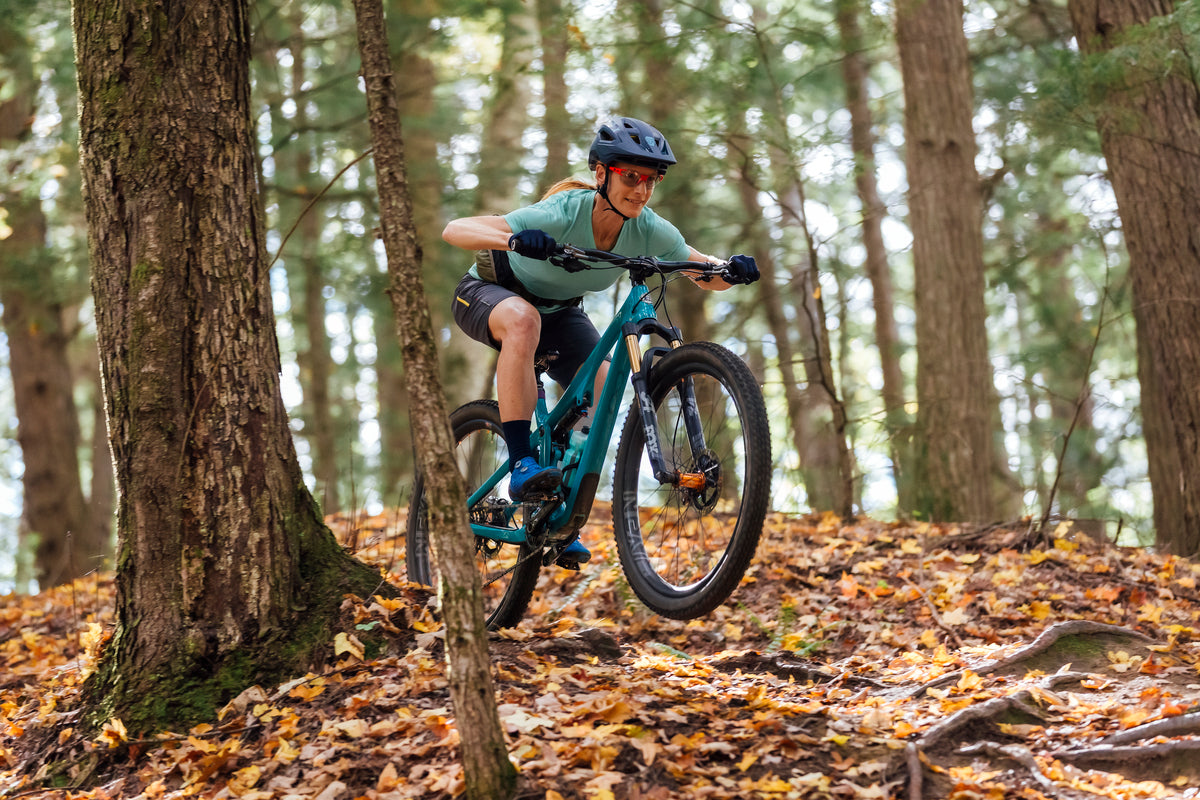What tire width is 2x EWS champ Richie Rude running? (See below for answers.) Photo: Dave Trumpore / Red Bull Content Pool
Tires are always a hot topic in mountain biking. Things like tread patterns, rubber compounds, and casings have a massive impact on how your bike performs. Then there’s the matter of tire width. With better technology, tire manufacturers have been making mountain bike tires wider and wider. The skinny 2” tires of yesteryear have given way to a huge selection of tires that can get as wide as 3”.
So how do you choose tire width for your mountain bike? Can you go too wide? The "right" tire width can be a confusing and contentious topic. We’ll boil it down to what's popular/what works best, and give you the practical advice you need to pick the perfect tire.
[button]SHOP MTB TIRES[/button] | [button]SHOP MOUNTAIN BIKES[/button]
Are wider MTB tires better?
 Are wider tires better? The simple answer is: Yes, usually. A more nuanced answer would be that it depends on your bike, riding style, and terrain, but most the industry is starting to settle on what the ideal tire width is.
Are wider tires better? The simple answer is: Yes, usually. A more nuanced answer would be that it depends on your bike, riding style, and terrain, but most the industry is starting to settle on what the ideal tire width is.
|
Wide tire PROS |
Wide tire CONS |
|
|
Wider tires have a bigger contact patch, which gives you more traction off-road. Because they have more volume, you can run lower tire pressures than you can on a narrower tire which also improves traction as well as comfort. As a result, wider tires can give riders more confidence when braking and cornering, and take some of the sting out of rough trails. If you’re looking for an upgrade that will give you the most performance for the least amount of money, switching to wider (and stickier) tires will give you the best bang for your buck.
There are a few potential downsides to wider tires. The most biggest is that a wider tire will be heavier than a narrow tire of similar construction. Generally, I like to say that bike weight doesn’t matter, but if you’re going to count grams, the rotating weight of your wheels and tires is where it matters most. A heavier tire will require more energy to accelerate, making tough climbs just a little bit tougher.
 Older bikes might not clear modern wide tires. It's a good thing this frame is covered in protective tape because it barely fits these 2.6" tires.
Older bikes might not clear modern wide tires. It's a good thing this frame is covered in protective tape because it barely fits these 2.6" tires.
Wider tires reduce the clearance for stones, mud, and other trail debris. They can even rub the frame. In the quest to squash wider and wider tires into frames with limited clearance, plenty of riders have experienced the agony of damaging their frame or paint. Always check the max tire width recommended from your bike manufacturer. Ideally, you want a minimum of 4-5mm of clearance between your tire and any part of the frame. More is better. If you plan to max out tire width on your bike, be prepared to see more marks, chips, and scratches in your bike's rear triangle.
The final point — feel — is a matter of personal preference. Some riders just don’t like the way overly wide tires steer or corner. Some riders find that wide tires feel vague or mushy. Sometimes it's because wider tires use lighter casings to keep weight down, which won't provide the cornering support of a stiffer sidewall. Sometimes it's because wider tires have wider knob spacing, which changes a tire's behavior when leaning transitioning onto the cornering knobs. And sometimes, it's related to rim width. Wider tires need wider rims to support them. If you want to go wide, it’s best to make sure your wheels have at least a 25mm internal rim width, with 27-33mm being ideal.
All that being said, the simplest advice I can give new-to-intermediate riders is to just fit the widest tires that their frame or wheels will allow. For most riders, the gains in traction, comfort, and confidence will far outweigh any potential downsides. Most riders likely won’t even notice the extra weight while riding because the benefits will be so pronounced.
Can you run different tire widths on the front and rear?
A common tactic many riders use is putting a wider tire on the front and a narrower tire on the rear. There are two reasons for this. First, most mountain bike forks can clear much larger tires than the frame can. Second, increasing tire volume makes a bigger difference at the front of the bike than in the rear. Many riders will run a wider front tire for more grip and comfort and pair it with a narrower rear tire that feels lighter and easier to pedal.
[newsletter]
The best XC MTB tire width: 2.35”-2.4”
 Nino Schurter has proven that 2.4" tires are the new normal for XC. Photo: Bartek Wolinski / Red Bull Content Pool
Nino Schurter has proven that 2.4" tires are the new normal for XC. Photo: Bartek Wolinski / Red Bull Content Pool
Cross-country mountain biking is all about efficiency, so for years, racers stuck to skinny 2” XC tires that were lighter, and thus (they thought) faster. But as tires have evolved, so has XC racing. I’ll provide a single example: Nino Schurter. If you don’t know, Schurter has won 10 Elite Men’s UCI World Championship titles, eight World Cup overall titles, and three Olympic medals (one gold, one silver, one bronze). He is undisputedly the best cross-country mountain biker of all time.
Schurter has stayed competitive at the top end of the sport for over 15 years, and in that time, his tires have gotten wider and wider. 10 years ago, he ran 2” wide Dugast tubulars. Before he won gold at the 2016 Rio Olympics, he switched to 2.25” Maxxis Aspens. Now, he’s gone full fat and won his most recent World Championship and World Cup overall titles on 2.4” Maxxis Aspens.
I usually tell riders to not copy the pros, but XC tire width selection is one of the rare exceptions. I think you should copy Schurter’s tire width choice because he has already done the legwork to figure out that the widest XC tires are still efficient enough to hold their own against the world’s fastest riders. They’re potentially more efficient than narrower tires because they can be run at lower pressures. This allows them to roll faster on rough surfaces because the tire can conform to the terrain, reducing rolling resistance. Add in the improvements in grip and comfort, and it's a win-win-win.
[product-block handle="maxxis-ikon-tire-29-x-2-35-tubeless-folding-black-3c-maxx-speed-exo-1"/]
Since they’ve become the latest performance benchmark, top tire manufacturers all produce a race- or trail-oriented XC tire in the 2.35”-2.4” range and most modern XC bikes can safely clear tires that wide. While 2.4” tires are heavier (usually 100-200 grams) than 2.25” tires, the extra traction and comfort they provide will be a major benefit to most XC riders. The only instance where a narrower tire might be preferable is on very smooth trails or hill climbs where weight and fast acceleration matter more.
Bottom line: Wider 2.35”-2.4” XC tires are currently the best mix of weight, traction, comfort, and rolling resistance, making them the perfect do-it-all XC option. 2.25” tires are lighter but are best reserved for smooth terrain or bikes that can't clear 2.4" tires.
The best trail/enduro/downhill MTB tire width: 2.4”-2.5”
 Downhill G.O.A.T. Greg Minnaar used a 2.5" front and 2.4" rear tire to win his 4th world championship. Photo: Bartek Wolinski / Red Bull Content Pool
Downhill G.O.A.T. Greg Minnaar used a 2.5" front and 2.4" rear tire to win his 4th world championship. Photo: Bartek Wolinski / Red Bull Content Pool
Consider these four legendary racers: Greg Minnaar, Sam Hill, Aaron Gwin, and Loic Bruni. Between them, they have 12 Elite Downhill World Championships and 13 World Cup overall wins. They are some of the most dominant and successful men’s downhill racers of all time. Look at their tires and you’ll see that tire width is the common denominator. They all use 2.4” tires, with the occasional 2.5” front tire. The same is true if you examine the women’s side of the sport and any of the tires favored by top pros in the Enduro World Series.
A 2.4" tire is quite wide, but there are wider tires out there and many modern trail, enduro, and downhill bikes can easily clear 2.6” tires. But at the highest level of the sport, riders tend to stick to 2.4” or 2.5” tires. If wider tires provide more traction and comfort, why haven’t 2.6” and wider tires proliferated? The answer goes back to feel.
Confidence is the key to going downhill fast, and while more traction and comfort will improve confidence, feel plays a major role too. Downhill and enduro racers are pushing their bikes to the limit, and many claim that wider tires don’t provide the aggressive cornering bite they need. It has been described to me as “knifing” into the dirt like a pizza cutter. Advanced riders rely on that locked-in feeling to corner fast, and as a tire gets wider, that feeling tends to get less pronounced. This could be due to factors like knob spacing and casing design, but for now, it seems like 2.4”-2.5” tires are the sweet spot.
[product-block handle="maxxis-assegai-tire-29x2-5-wide-trail-3c-maxx-terra-exo-casing-tubeless"/]
Unlike XC tires, however, I don’t think every rider should copy the pros when it comes to trail, enduro, or downhill tires. Most of us don’t have the speed, skills, or fearlessness that pros process. For us mere mortals, a wider 2.6” tire that feels more forgiving because it doesn't have such an aggressive bite might be exactly what we need to feel confident on gnarly trails.
At the narrower end of the spectrum, 2.3” trail tires are a common option, but I think they’re best reserved for mellower trails, bikes with limited tire clearance, or weight weenie trail builds. And what about 2.35” tires? To me, they might as well be lumped in with 2.4” tires. Many 2.35” trail tires measure up wider once mounted.
Bottom line: Riders going for maximum speed and performance should stick to the proven 2.4”-2.5” tire options. For general trail riding, any tire between 2.35” and 2.6” will work great, but most regular riders will probably feel more confident riding a bigger 2.6” tire.
What about plus bikes?
Plus bikes that use 27.5+ or 29+ wheels and tires are much more limited when it comes to tire width. The only options are pretty much 2.8” and 3.0” wide tires. 2.8” tires are far more common, and usually the preferred choice for all-around riding because they strike a good balance between weight, durability, and feel. Bigger 3.0” tires are a good option if traction is your top priority for loose surfaces like snow or sand.
Final thoughts
 Tire width is a personal choice, so just because I say a particular width is better, or a bunch of pros all run a particular width, doesn’t mean you have to. Maybe weight matters more to you than anything else. If that’s the case, run the skinniest, lightest tire possible if that’s what makes you happy. Maybe your trails are buffed out and look nothing like the rock-strewn gnar fests World Cup racers compete on. Then maybe a beefy 2.5” tire is overkill and a 2.3” trail tire actually makes a lot more sense. Ultimately, tires are the one component of your mountain bike where you should experiment to find what works best for you and your trails. My recommendations should act as a jumping off point.
Tire width is a personal choice, so just because I say a particular width is better, or a bunch of pros all run a particular width, doesn’t mean you have to. Maybe weight matters more to you than anything else. If that’s the case, run the skinniest, lightest tire possible if that’s what makes you happy. Maybe your trails are buffed out and look nothing like the rock-strewn gnar fests World Cup racers compete on. Then maybe a beefy 2.5” tire is overkill and a 2.3” trail tire actually makes a lot more sense. Ultimately, tires are the one component of your mountain bike where you should experiment to find what works best for you and your trails. My recommendations should act as a jumping off point.
One exciting thing is that mountain bikes and tires are going to continue to evolve. In another 10 years, maybe technology and trends will result in tires that are even wider. Maybe they’ll go narrow again. But for right now, the XC, trail, enduro, and downhill tire widths described above are the gold standard.
Do you agree or disagree with my tire width assessment? Tell me why I’m wrong or tell me about your preferred tire width in the comments!
[button]SHOP MTB TIRES[/button] | [button]SHOP MOUNTAIN BIKES[/button]













